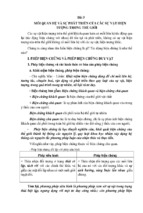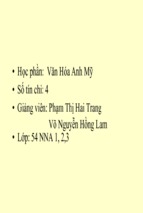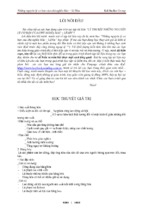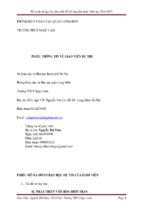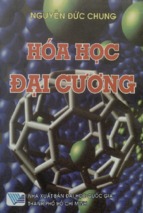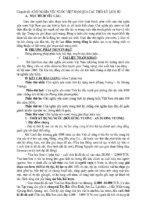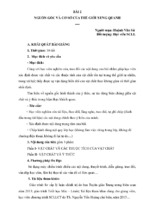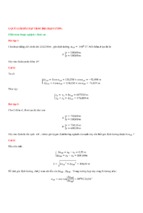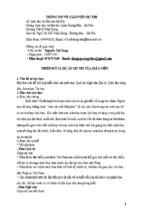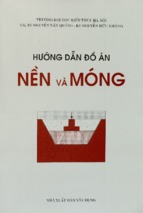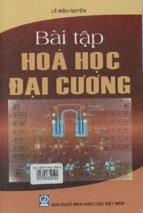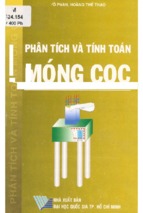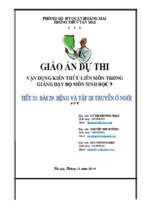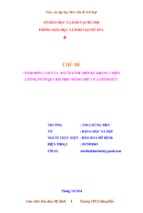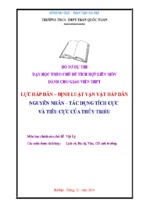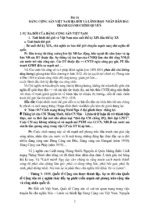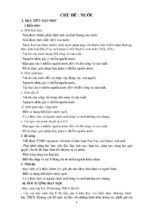d from ascelibrary.org by RMIT UNIVERSITY LIBRARY on 01/04/19. Copyright ASCE. For personal use only; all right
Infrastructure Resilience Publication No. 1
International
Collaboration in
Lifeline Earthquake
Engineering 2016
Proceedings of the Seventh China-Japan-US Trilateral
Symposium on Lifeline Earthquake Engineering
Shanghai, China • June 1–4, 2016
Edited by
Craig Davis, Jie Li, Masakatsu Miyajima,
Liping Yan, Xiaoqiu Ai, and Haizhong Wang
Downloaded from ascelibrary.org by RMIT UNIVERSITY LIBRARY on 01/04/19. Copyright ASCE. For personal use only; all rights reserved.
INFRASTRUCTURE RESILIENCE
PUBLICATION
NO.
1
INTERNATIONAL COLLABORATION
IN LIFELINE EARTHQUAKE
ENGINEERING 2016
PROCEEDINGS OF THE SEVENTH CHINA-JAPAN-US TRILATERAL SYMPOSIUM
ON LIFELINE EARTHQUAKE ENGINEERING
June 1–4, 2016
Shanghai, China
SPONSORED BY
Shanghai Institute of Disaster Prevention and Relief
Tongji University
Beijing University of Technology
International Society of Lifeline and Infrastructures Earthquake Engineering
Kanazawa University
Lifeline Network (LiNK)
Japan Ductile Iron Pipe Association
Infrastructure Resilience Division of the
American Society of Civil Engineers
EDITED BY
Craig Davis
Jie Li
Masakatsu Miyajima
Liping Yan
Xiaoqiu Ai
Haizhong Wang
Published by the American Society of Civil Engineers
Downloaded from ascelibrary.org by RMIT UNIVERSITY LIBRARY on 01/04/19. Copyright ASCE. For personal use only; all rights reserved.
Published by American Society of Civil Engineers
1801 Alexander Bell Drive
Reston, Virginia, 20191-4382
www.asce.org/publications | ascelibrary.org
Any statements expressed in these materials are those of the individual authors and do not
necessarily represent the views of ASCE, which takes no responsibility for any statement
made herein. No reference made in this publication to any specific method, product, process,
or service constitutes or implies an endorsement, recommendation, or warranty thereof by
ASCE. The materials are for general information only and do not represent a standard of
ASCE, nor are they intended as a reference in purchase specifications, contracts, regulations,
statutes, or any other legal document. ASCE makes no representation or warranty of any
kind, whether express or implied, concerning the accuracy, completeness, suitability, or
utility of any information, apparatus, product, or process discussed in this publication, and
assumes no liability therefor. The information contained in these materials should not be used
without first securing competent advice with respect to its suitability for any general or
specific application. Anyone utilizing such information assumes all liability arising from such
use, including but not limited to infringement of any patent or patents.
ASCE and American Society of Civil Engineers—Registered in U.S. Patent and Trademark
Office.
Photocopies and permissions. Permission to photocopy or reproduce material from ASCE
publications can be requested by sending an e-mail to
[email protected] or by locating a
title in ASCE's Civil Engineering Database (http://cedb.asce.org) or ASCE Library
(http://ascelibrary.org) and using the “Permissions” link.
Errata: Errata, if any, can be found at https://doi.org/10.1061/9780784480342
Copyright © 2017 by the American Society of Civil Engineers.
All Rights Reserved.
ISBN 978-0-7844-8034-2 (PDF)
Manufactured in the United States of America.
Front cover: Professor Michael O’Rourke
International Collaboration in Lifeline Earthquake Engineering 2016 IRP 1
Preface
Downloaded from ascelibrary.org by RMIT UNIVERSITY LIBRARY on 01/04/19. Copyright ASCE. For personal use only; all rights reserved.
The Seventh China-Japan-US Trilateral Symposium on Lifeline Earthquake
Engineering (Symposium) was held in Shanghai, China from June 1 to 4, 2016. The
Symposium attracted over 83 attendees, many of whom were students, consisting of 10
delegates representing the United States, 13 from Japan, and more than 60 from China.
This Symposium included participants from three additional countries - New Zealand,
Turkey, and Canada. The Shanghai Institute of Disaster Prevention and Relief, Tongji
University, Shanghai, China served as primary organizer and hosted this Symposium and
co-organized in collaboration with The International Society of Lifeline and
Infrastructure Earthquake Engineering (ISLIEE), Kanazawa University, Japan, and the
American Society of Civil Engineers Infrastructure Resilience Division (IRD), USA.
Prof. Jie Li of Tongji University took the role of chief organizer, and Prof. Masakatsu
Miyajima of Kanazawa University and Dr. Craig A. Davis of Los Angeles Department of
Water and Power served as coordinators for Japan and US, respectively. Prof. Xiuli Du of
Beijing University of Technology served as coordinator for ISLIEE.
This Symposium was organized in cooperation with the Shanghai Institute of
Disaster Prevention and Relief, China, Tongji University; Shanghai, China, Beijing
University of Technology, Beijing, China; ISLIEE; Kanazawa University, Japan; Lifeline
Network Kansai (LiNK) Japan; Japan Ductile Iron Pipe Association; and the American
Society of Civil Engineers IRD, US.
The first China-Japan Symposium on Lifeline Earthquake Engineering was held
in 1990 at Beijing, China on the cooperative research between the Central Research
Institute of Building and Construction in China and Kobe University in Japan containing
wider researchers and engineers in China and Japan who were interested in Lifeline
Earthquake Engineering. The second as a trilateral Symposium of China, Japan, and US
joint programs was held in 1994 at Xi’an, China under the official US-China protocol
program on cooperative earthquake engineering studies. The third, fourth, fifth, and sixth
Symposiums were held in 1998 at Kunming, 2002 at Qingdao, 2007 at Haikou, China,
and 2013 at Chengdu, China, respectively.
The objective of this seventh Symposium was to provide a forum for professional
lifeline earthquake engineers and researchers in China, Japan, United States, and
elsewhere for mutual exchange of recent results of main investigations on lifeline
earthquake engineering, including water, wastewater, gas and liquid fuels, electric power,
telecommunication, and transportation systems. Transportation includes roads and
highways, ports (sea and air) and harbors, rail, and other transport systems and critical
components in which communities are dependent upon. Recent severe earthquakes
including 2008 China, 2009 Indonesia, 2010 Haiti, 2010 Chile, 2010-2011 New Zealand
sequence, the 2011 and 2016 Japan, and 2015 Nepal earthquakes caused not only the
direct losses of damaged lifeline facilities, but also severe indirect losses and community
impacts caused by the interruption and long-term restoration of lifeline system functions.
Seismic resilience incorporates the systemic loss and temporal recovery and is therefore a
very important issue for managing community impacts and the physical and functional
damages related to lifelines. The issue of seismic resilience for lifelines was emphasized
in this seventh Symposium.
© ASCE
iii
International Collaboration in Lifeline Earthquake Engineering 2016 IRP 1
Downloaded from ascelibrary.org by RMIT UNIVERSITY LIBRARY on 01/04/19. Copyright ASCE. For personal use only; all rights reserved.
In the Symposium, three keynote lectures, six invited presentations, and 82
technical papers were presented. The keynote lectures were given by Professor Shiro
Takada, Professor Emeritus, Kobe University, Professor Jean-Pierre Bardet, Dean of the
College of Engineering University of Miami, and Prof. Hong-Nan Li, Chair Professor of
Infrastructure Engineering, Dalian University of Technology. The invited presentations
were given by Professor Hui Li, Harbin Institute of Technology, Professor Yasuko
Kuwata, Kobe University, Professor Yoshihisa Maruyama, Chiba University, Professor
Jianwen Liang, Tianjin University, Alex Tang, President, L&T Consulting, and Dr. Endi
Zhai Chief Engineer for Civil Works and Director of Chief Engineer's Office, China
Three Gorges Corporation.
Many papers were presented by younger practitioners, researchers, and students,
showing how interest in lifeline earthquake engineering practice and research continues
to grow. These proceedings contain 77 papers, including those presented at the
Symposium. The papers cover a wide variety of topics relevant to lifeline earthquake
engineering including: seismicity, ground motions, and site effects; seismic performance,
modeling, evaluation, and design of water supply, sewage, electric power, gas and liquid
fuel, telecommunication, and transportation systems and their components; seismic
reliability and post-earthquake serviceability, recovery and resilience of lifeline systems;
lifeline interactions; tunnels and underground structures; geotechnical and structural
earthquake behavior related to lifelines; seismic testing and analysis for lifeline
components and foundations (e.g., pipes, bridges, etc.); tsunami impacts, and a special
session on bridge impact loads.
The purpose of these proceedings is to publish the high quality work that is being
undertaken internationally in lifeline earthquake engineering and presented at the
Symposium. The papers were first intended to initiate and foster discussion and
intellectual exchange during the Symposium. Following the Symposium these
proceedings are intended to make the papers available to others. This is the second time
the proceedings from this series of lifeline earthquake engineering Symposiums has been
formally published and engineering indexed. To ensure high caliber papers, each paper
submitted underwent a stringent review for technical, grammatical, and format aspects.
Each paper underwent at least two levels of review. The papers were screened by
members of the Technical Committee from their respective countries to ensure each was
original, pertinent to the Symposium, understandable and written in good English, and
had good technical quality providing an important contribution to lifeline earthquake
engineering. The papers from China were also reviewed and edited by English language
technical editors. The resulting works provided a high quality experience for Symposium
attendees and helped foster a good discussion and exchange of practice, experiment, and
theoretical knowledge.
The ISLIEE was formed to enhance the international collaboration and
development in lifeline and infrastructure engineering research and practice, including
the coordination of this series of symposiums. The eighth symposium is currently being
planned for 2018 at Shenyang Jianzhu University, China. The eighth symposium will
encourage greater participation from other countries and younger members. This is
intended to enhance the international collaboration and development in lifeline and
infrastructure engineering research and practice.
© ASCE
iv
International Collaboration in Lifeline Earthquake Engineering 2016 IRP 1
The contributions of numerous individuals and participants from the participating
countries are acknowledged. The outstanding efforts of Dr. Xiaoqiu Ai of Tongji
University, for performing the primary coordinating duties and accomplishing successful
Symposium are gratefully acknowledged.
Downloaded from ascelibrary.org by RMIT UNIVERSITY LIBRARY on 01/04/19. Copyright ASCE. For personal use only; all rights reserved.
Editors
Craig A. Davis
Los Angeles Department of Water and Power
Jie Li
Tongji University
Masakatsu Miyajima
Kanazawa University
Liping Yan
Los Angeles Department of Water and Power
Xiaoqiu Ai
Tongji University
Haizhong Wang
Oregon State University
June 2016
© ASCE
v
International Collaboration in Lifeline Earthquake Engineering 2016 IRP 1
Contents
Downloaded from ascelibrary.org by RMIT UNIVERSITY LIBRARY on 01/04/19. Copyright ASCE. For personal use only; all rights reserved.
Bridge Analysis
Numerical Synthesis Method of Ground Motions for Seismic Design of
Near-Fault Bridge Engineering ....................................................................................................1
Shuanglan Wu, Bhuddarak Charatpangoon, and Junji Kiyono
Bridge Collision
Evaluation of Large-Scale Composite Bumper System for Bridge Piers .................................9
Lu Zhu, Hai Fang, and Weiqing Liu
Index of Bending Performance for RC Columns under Impact Loadings ............................14
Yanchen Song, Junjie Wang, and Junsheng Su
Research on the Reasonable Stiffness of Bridge Anti-Collision Devices ................................22
Bo Geng, Songlin Li, and Zhi Zheng
Simplified Impact Force Time History Model of Barge Pier Collisions .................................30
Haijiao Yin and Junjie Wang
Finite Element Analysis of the Nonlinear Collision between 300k DWT
VLCC and Bridge Pier ................................................................................................................38
Zhen-Biao Hu, Ke-Cheng Zhang, Yao-Hua Fu, and Yun-Long Jin
Experimental Study on the Behavior of Hot-Rolled Square Tubular
T-Joints under Impact Loadings ................................................................................................45
Pengfei Cui, Fan Chen, Yanzhi Liu, and Jingsi Huo
Time Variation Characteristics of Impact Force in Collision of Heavy
Vehicle to the Bridge Pier............................................................................................................53
Jiang Qian, Juan Wang, Wuchao Zhao, and Deyuan Zhou
Design Method of Steel Plate-Rubber Energy Absorption Ring .............................................60
Lingfeng Tu, Junjie Wang, Zheng Zhu, and Yanchen Song
Experimental Study on Flexural Behavior of Impact-Damaged
Reinforced Concrete Beams ........................................................................................................69
Hanqing Liu, Kaiying Hu, Jingsi Huo, and Yanzhi Liu
Bridges
Fiber-Based Damage Analysis of Circular RC Bridge Columns.............................................77
Junsheng Su and Junjie Wang
© ASCE
vi
International Collaboration in Lifeline Earthquake Engineering 2016 IRP 1
Downloaded from ascelibrary.org by RMIT UNIVERSITY LIBRARY on 01/04/19. Copyright ASCE. For personal use only; all rights reserved.
Seismic Response Analysis of High-Speed Operating Train-Bridge
Coupling System...........................................................................................................................84
E. D. Guo, S. J. Liang, Z. Liu, and H. X. Li
Multiple Hazard Bridge Design ..................................................................................................92
De-Zhang Sun, Xu Wang, Si-Han Li, Bai-Tao Sun, Huan-Zhen Lei,
and Ren-Peng Zhang
Seismic Response Analysis of Yokohama-Bay Bridge Considering
Pounding between Wind-Tongue and Wind-Shoe and Safety Evaluation
during the 2011 Great East Japan Earthquake ........................................................................99
T. Takeda, T. Mizutani, T. Nagayama, and Y. Fujino
Effectiveness of Rubber Cushion to Mitigate Pounding between
Girders and Blocks of Curved Bridge Subjected to Strong Ground Motion .......................107
Bo Song, Jing-Xia Cheng, and Yan-Xu Wang
The Earthquake Response Analysis of the Niulanjiang Bridge
during the 2014 Ludian Earthquake in China ........................................................................115
Yong Huang, Liang Zhang, Haidong Qiao, Rui Li, and Weijie Le
Influence of Pounding on the Girder Unseating Potential of Skewed Bridges ....................122
C. Kun and N. Chouw
Study on Seismic Alarm Threshold Value for High Speed Train on
Bridge Considering Train-Bridge Coupling Effect ................................................................128
Z. Liu, H. Jiang, and E. D. Guo
Study on Dynamic Response Characteristics of a Bridge in Beijing.....................................136
Fei Wang, Hongkui Ge, and Xiandong Kang
Routine Health Monitoring of a Long-Span Suspension Bridge Based
on Strong Motion Monitoring System......................................................................................143
J. J. Zhu, L. X. Wang, and X. R. Zhao
Field Testing and Analysis of a Maglev Guideway PC Girder with
Unbonded Post-Tensioning Curvilinear Tendons ..................................................................150
S. J. Chen, S. Z. Li, W. J. Sun, and Y. Zhang
Seismic Damage Analysis of Concrete Girder Bridges Subjected to
Near-Fault Ground Motions .....................................................................................................158
Ying Zhang, Guangjun Sun, and Hongjing Li
Correlation Definition of Bridge Seismic Performance by Numerical
Approach ....................................................................................................................................165
Jianjun Qin and Yao Liu
© ASCE
vii
International Collaboration in Lifeline Earthquake Engineering 2016 IRP 1
Buried Reservoirs
Downloaded from ascelibrary.org by RMIT UNIVERSITY LIBRARY on 01/04/19. Copyright ASCE. For personal use only; all rights reserved.
A Centrifuge Study: Influence of Site Response on the Seismic
Performance of Buried Reservoir Structures..........................................................................171
A. Hushmand, S. Dashti, and C. Davis
Communications
Study on the Whiplash Effect of Communication Tower Fixed on
the Top of Buildings ...................................................................................................................178
A. W. Liu, Y. D. Wang, and B. W. Hou
Cooling Towers
Study on the Application of Base Isolation for the Ultra Large Cooling
Tower Structure .........................................................................................................................186
Yongbin Liu, Guofang Zeng, Junwu Dai, and Yongqiang Yang
Damping Equipment
Experimental Studies of the Mechanism of Particle Dampers Based
on an SDOF Structure under Harmonic Excitation ...............................................................194
Jin Wang, Weiming Yan, and Weibing Xu
Electric Power
Seismic Damage Investigation and Analysis of Electric Power System
in Nepal Ms 8.1 Earthquake .....................................................................................................201
Jin-Long Liu and Yong Huang
Seismic Fragility of Power Distribution Systems ....................................................................212
John Eidinger, Alex K. Tang, Eric Fujisaki, Joseph Sun, and Raymond Trinh
Electrical Equipment
Seismic Protection of Porcelain Cylindrical Electrical Equipment
Based on MTMD ........................................................................................................................219
Wen Bai, Junwu Dai, Xiaoqing Ning, and Huimeng Zhou
Energy and Power Systems
Assessment of Tsunami Inundation Exposure of Energy-Related
Base Facilities Caused by Anticipated Nankai Megathrust Earthquakes ............................226
N. Nojima and H. Kato
Effect of Initial Geometrical Imperfections on Buckling Strength and
Design of Offshore Wind Turbine Tower ................................................................................234
Nu Nu Lwin and Bo Song
© ASCE
viii
International Collaboration in Lifeline Earthquake Engineering 2016 IRP 1
Dynamic Nonlinear Time-History Analysis of Nuclear Power Plant
under Near-Fault Ground Motion with Velocity Pulse ..........................................................242
Qiumei He, Xiaojun Li, Yaqi Li, Aiwen Liu, and Jiangwei Zhang
Downloaded from ascelibrary.org by RMIT UNIVERSITY LIBRARY on 01/04/19. Copyright ASCE. For personal use only; all rights reserved.
Interdependencies
Lifeline Interrelation during the Tohoku Earthquake: Analysis
through Text Mining..................................................................................................................250
Yasuko Kuwata
Isolation Systems
Parameters Optimization and Energy Analysis of Inter-Story
Isolation System .........................................................................................................................257
Xiangxiu Li, Ping Tan, Xiaojun Li, and Aiwen Liu
Liquefaction
The Development of Software for Deterministic Assessment of
Seismic Soil Liquefaction ..........................................................................................................265
Su Chen, Baizan Tang, and Xiaojun Li
Oil and Gas
Rapid Seismic Disaster Assessment of Oil and Gas Pipeline Based
on the Shakemap ........................................................................................................................272
A. W. Liu, B. W. Hou, J. Liu, and Y. D. Wang
Pavement
Numerical Simulation on the Composited Pavement Slab Subjected
to Multiple Drop Weight Impact ..............................................................................................278
Jun Wu, Liang Li, and Xiuli Du
Pile Foundations
An Investigation on the Parameter Study of Soil-Pile Spring Model
of Seismic Bridge ........................................................................................................................284
Hao Gao and Junjie Wang
Effect of Pile Diameter on the Seismic Performance of Pile Foundation .............................293
Ning Wang, Ahmed Elgamal, Xiaojun Li, and Jinchi Lu
Pipeline Networks
Seismic Reliability Evaluation of Pipeline Networks under Spatially
Correlated Ground Motions .....................................................................................................301
Benwei Hou, Na Yang, Xiaojun Li, Xiuli Du, and Aiwen Liu
© ASCE
ix
International Collaboration in Lifeline Earthquake Engineering 2016 IRP 1
Pipelines
Downloaded from ascelibrary.org by RMIT UNIVERSITY LIBRARY on 01/04/19. Copyright ASCE. For personal use only; all rights reserved.
Experimental Study on Dynamic Soil Friction along a Buried Pipe .....................................309
Tomoaki Hirayama, Yasuko Kuwata, Tomoki Inase, and Sumio Sawada
Seismic Analysis and Test of Bracings Used in Piping Systems ............................................316
Xiaoqing Ning, Junwu Dai, and Duozhi Wang
Characteristics of Pipeline Damages in the 2014 Northern Nagano
Prefecture Earthquake in Japan ..............................................................................................322
Mitsuo Hayashi, Keita Oda, and Masakatsu Miyajima
Ultimate Soil Bearing Capacity of Buried Pipeline-Silt Clay Lateral
Interaction ..................................................................................................................................331
Li-Yun Li, Xiao Zuo, Jin-Long Li, Xin-Lei Sha, Zi-Lan Zhong, and Xiu-Li Du
Research on Accidents of Urban Underground Pipelines from 2000
to 2014 in China .........................................................................................................................338
Heyun Zhu and Qunfang Hu
Traveling Wave Effect Analysis of Long-Span Suspension Cable
Pipeline Aerial Crossing Structure Based on Capacity to Demand Ratio ............................345
K. Yan, L. X. Wang, H. Jiang, and J. J. Zhu
The Seismic Response Test of a Buried Pipe Network Subjected to
Artificial Earthquake Produced by Multi-Millisecond Blasting ...........................................352
Huiquan Miao, Wei Liu, Chuang Wang, and Jie Li
The Performance of Thames Water Pipeline at the Kullar Fault Crossing .........................359
E. Uckan, E. S. Kaya, M. O’Rourke, F. Cakir, and B. Akbas
Post-Earthquake Flooding
Cause of Residual Flooding after the Great East Japan Earthquake
and Tsunami ...............................................................................................................................366
C. A. Davis
Railways
Study on the Influence of Rainfall Condition on the Stability of Railway
Slope ............................................................................................................................................374
Bo Song and Xiao-Min Hao
Roadways
Shaking Table Tests on a Deformation Mitigation Method for Road
Embankment during Liquefaction by Using Gravel and Geosynthetics ..............................384
Masaho Yoshida, Ryo Hashimoto, and Yoshinao Kurachi
© ASCE
x
International Collaboration in Lifeline Earthquake Engineering 2016 IRP 1
Seismic and Strong Ground Motions
Downloaded from ascelibrary.org by RMIT UNIVERSITY LIBRARY on 01/04/19. Copyright ASCE. For personal use only; all rights reserved.
Random Model of Earthquake Ground Motion for Engineering Site
Basing on Stochastic Physical Process .....................................................................................390
X. Q. Ai and J. Li
Effects of Near-Fault Ground Motions on a Large Underground Rock
Cavern: A Case Study ...............................................................................................................396
Zhen Cui and Qian Sheng
Practical Simulation Method of Non-Stationary Earthquake Ground
Motion Based on Frequency-Dependent Amplitude Envelope Function .............................405
Guoyan Qu, Xiabo Liu, and Ruifang Yu
Simulation of Significant Duration of Near-Field Earthquakes in
Kyushu, Japan, 1997, MJMA6.5 by Empirical Green Function Method ...............................412
Zongchao Li, Xueliang Chen, and Mengtan Gao
Studying Yuxi Basin’s Amplification Effect on Long-Period Ground
Motion by Numerical Simulation Method ...............................................................................419
Changhua Fu and Mengtan Gao
Coherency of Synthetic Earthquake Ground Motion for the Design of
Long Structures: Effect of Site Conditions ..............................................................................427
Maria I. Todorovska, Haiping Ding, and Mihailo D. Trifunac
Study on the Earthquake Catalogue and the Seismicity of North
China, Mongolia, and Adjacent Areas .....................................................................................435
G. Y. Xu, S. Y. Wang, A. J. Gao, and S. Demberel
Research on Earthquake and Wave Simultaneously Induced Pore
Pressure in Seabed .....................................................................................................................442
Hao Xiong, Kai Zhao, and Guoxing Chen
Structural Analysis
Validation of the Modified Irregular Unloading-Reloading Rules
Based on Davidenkov Skeleton Curve and the Implementation in
ABAQUS Software.....................................................................................................................449
Dingfeng Zhao, Bin Ruan, and Guoxing Chen
Subways
Monitoring of Los Angeles Metro Red Line Subway: Earthquake
Response Adjacent to Deep Excavation ...................................................................................456
Martin B. Hudson and Marshall Lew
© ASCE
xi
International Collaboration in Lifeline Earthquake Engineering 2016 IRP 1
Subway Stations
Downloaded from ascelibrary.org by RMIT UNIVERSITY LIBRARY on 01/04/19. Copyright ASCE. For personal use only; all rights reserved.
Numerical Simulation on Seismic Behavior of Variable Cross-Section
Subway Station Structure in Complex Geological Ground ...................................................464
Baizan Tang, Su Chen, Xiaojun Li, Aiwen Liu, and Guoxing Chen
Telecommunications
Opportunities of Achieving Telecommunication Lifeline Systems
Resilience ....................................................................................................................................471
Alex K. Tang
Transportation
Estimation of the Restoration Time of Expressways following Recent
Earthquakes in Japan ................................................................................................................478
Yoshihisa Maruyama and Kohei Uehara
Post-Earthquake Performance Assessment of Highway Networks
Based on Monte Carlo Simulation............................................................................................485
Benwei Hou, Xiaojun Li, Aiwen Liu, Xiuli Du, and Qiang Han
Methodology for Seismic Risk Assessment of Urban Transportation
Networks .....................................................................................................................................493
Riqing Lan, Xiaojun Li, Yushi Wang, and Zhenghui Xiong
Post-Disaster Mobility in Disrupted Transportation Network: Case
Study of Portland, Oregon ........................................................................................................501
Shangjia Dong, Alireza Mostafizi, Haizhong Wang, and Peter Bosa
Tunnels
Numerical Simulation Analysis of Immersed Tunnel-Joints-Soil .........................................508
Hongjuan Chen, Xiaojun Li, Weiming Yan, Shicai Chen,
and Xueming Zhang
Analysis of the Risk by Long-Term Settlement for Double-Line
Cross-River Shield Tunnels—Take the Tunnel through Qiantang
River as an Example ..................................................................................................................514
Yongmei Zhai, Senlon Zen, and Zhigang Cui
Water Systems
Water Tank Damage Survey and Analysis of Relationship with
Strong Ground Motions in the 2011 Great East Japan Earthquake ....................................521
R. Inoue, F. Sakai, and S. Omine
© ASCE
xii
International Collaboration in Lifeline Earthquake Engineering 2016 IRP 1
Downloaded from ascelibrary.org by RMIT UNIVERSITY LIBRARY on 01/04/19. Copyright ASCE. For personal use only; all rights reserved.
Emergency Assessment Method for Earthquake Damage to Water
Supply Pipeline Network ...........................................................................................................528
E. D. Guo, T. Y. Yu, R. Q. Zou, Q. Li, and C. X. Mao
Acoustic Emission (AE) Based Leak Detection of Water Distribution
Pipeline Subject to Failure of Socket Joint Using Logistic Regression
Algorithm ....................................................................................................................................536
G. Q. Zhou and S. Z. Li
A Simplified Seismic Design Method of Water Lifelines in Developing
Countries.....................................................................................................................................543
Khin Aye Mon, T. Koike, G. Nishikawa, L. E. Garciano, and J. Kiyono
Damage Analysis of Water Supply System in Heavy Rain Disasters ....................................550
N. Iwamoto and M. Miyajima
Study on Abrupt Decrease of Water Pressure in Drinking Water
System Just after Earthquake...................................................................................................558
Akihisa Ishida, Masakatsu Miyajima, and Mitsuyasu Tamase
Wave Propagation
Implementation of Transmitting Boundary Condition in the Spectral
Element Analysis of Seismic Wave Propagation .....................................................................565
Haojie Xing and Hongjing Li
© ASCE
xiii
International Collaboration in Lifeline Earthquake Engineering 2016 IRP 1
1
Numerical Synthesis Method of Ground Motions for Seismic Design of Near-Fault Bridge
Engineering
1
2
Shuanglan Wu ; Bhuddarak Charatpangoon ; and Junji Kiyono
3
Downloaded from ascelibrary.org by RMIT UNIVERSITY LIBRARY on 01/04/19. Copyright ASCE. For personal use only; all rights reserved.
1
Earthquake and Lifeline Laboratory, Dept. of Urban Management, Kyoto Univ., C1-2-146,
Kyoto-Daigaku Katsura, Nishikyo-ku, Kyoto, Japan, P.O. Box 615-8540. E-mail:
[email protected]
2
Dept. of Civil Engineering, Faculty of Engineering, Chiang Mai Univ., 239, Huay Kaew Rd.,
Muang District, Chiang Mai, P.O. Box 50200. E-mail:
[email protected]
3
Graduate School of Global Environmental Studies, Kyoto Univ., C1-2-137, Kyoto-Daigaku
Katsura, Nishikyo-ku, Kyoto, Japan, P.O. Box 615-8540. E-mail:
[email protected]
ABSTRACT
Spatially extended long-span bridges, which crossing an active fault or located near fault area
are subjected to both static step-like deformation and dynamic ground motions. Due to there are
lack of near-fault recordings, numerical simulations of near fault time-histories are required. This
paper proposes a hybrid synthesis method combining the modified statistical Green’s function
and theoretical Green’s function. It considers both the dynamic vibration and static terms
(namely permanent displacement) of the near-fault strong ground motion, also the simulation
simply considered the complete seismic waveforms including the near-, intermediate-, and farfield terms. Then by this synthesis method, near-fault ground motions are calculated as the input
time-histories to analyze seismic response of a simple bridge. The results well showed the
applicable of this method provides a useful reference for seismic design guidelines for near-fault
bridge engineering.
INTRODUCTION
At recent decades, a number of significant inland earthquakes tragically occurred
successively, such as the 1994 Northridge, California, the 1995 Kobe, Japan, 1999 Jiji, Taiwan
earthquakes, and the 2008 Wenchuan earthquake. These seismic events had devastating effects
on urban infrastructures, especially the fault cross the bridge or very near the bridges. For
example, during the 1999 Jiji earthquake, Taiwan, the strong earthquake induced the surface
rupturing in horizontal and vertical direction of 3~9m, and caused large collapse and failure in
the near-fault or the faulting crossing bridges as the Fig. 1 (Yingxin, H. et al., 2014) showing. As
for the near-fault ground motion, it features the fling effects and the impulsive in velocity, and
the fling-containing time histories are required when conducting dynamic time-history analysis
for bridge engineering located in proximity to potential faults (typically up to 15-20 km) (Kamai,
R., et al. 2014), to properly account for the near-source ground motions containing near-source
effects. While up to date, the effects of near-fault ground motion on structures were
underestimated, and very few studies have addressed this problem. A rational seismic design
philosophy for bridges crossing active faults or located near the fault has not been established
yet. Also due to there are very few existing earthquake records that contain fling effects, the
numerical techniques generating reliable ground motions appropriate for the engineering to
design spatially extended structures is required. Thus, in this paper, it proposed a simple
synthesis hybrid method combining the statistical Green’s function and theoretical Green’s
function for simulating the near-fault ground displacements.
© ASCE
Downloaded from ascelibrary.org by RMIT UNIVERSITY LIBRARY on 01/04/19. Copyright ASCE. For personal use only; all rights reserved.
International Collaboration in Lifeline Earthquake Engineering 2016 IRP 1
Figure 1. The destructive and collapse of bridges near-source (Yingxin, H. et al. 2014)
SYNTHESIS PROCEDURE OF NEAR-FAULT GROUND MOTION
As Mavroeidis, G. P. (2003) mentioned, an estimate of static, dynamic and total permanent
displacements are required in the near-fault ground motions to decouple permanent-translation
pulse from directivity pulse. In terms of the simulated time histories, a broad range of fault types
(e.g. strike-slip, normal or reverse faulting), to characterize motions is highly required, as well as
variable slip and full kinematic description of the rupture process. Thus, the ground motions of
short distance to source cannot be neglected. We here proposed a hybrid method that combines
modified statistical Green’s function dynamic and theoretical Green’s function for calculating
the dynamic and static terms, respectively, to simulate the near-fault strong ground motions.
Modified statistical Green’s function: The basic idea of the statistical Green’s function
method is: a large earthquake is composed of a series of small earthquakes; records of small
earthquakes or statistically calculated small earthquakes are selected properly as ground response
caused by small areal sources, namely statistical or empirical Green’s functions which are then
overlaid by specified cracking ways to obtain the time-history curve of large earthquake. And
Eq. (1) listed the main procedure, and more details can be checked in papers Irikura, K. (1983),
Kamae et al. (1991), and Irikura, K. and Miyake, H. (from web site: http://kojiroirikura.jp/pdf/Workshop_irikura.pdf.), (Irikura 1986) and Fig. 2. Even if the distance to fault is
very short, the dynamic ground motion can be calculated by superposing small element
waveforms. As the original statistical Green’s function method, proposed by Kamae et al.
(1991), in which only the far-field S-waves from the stochastic point source (Boore 1983) are
superposed on an extended fault plane using the empirical Green’s function technique (Irikura
1986). While, in this paper, in order to introduce the near-, intermediate-, and far-filed waves to
obtain the complete waveforms of near-fault ground motions, based on the method proposed by
Astushi. N. (2006), the conventional stochastic Green’s function method, through using the
ration of Fourier transform of total wave, is applied for calculating the dynamic terms.
© ASCE
2
International Collaboration in Lifeline Earthquake Engineering 2016 IRP 1
NL NW
U (t )
r0
r
m 1 n 1 mn
3
( ND 1) n '
NL NW r0
1
u (t tmn k
)
u '(t tmn )
u (t tmn )
n'
( ND 1)n ' m1 n 1 rmn
k 1
(1)
Downloaded from ascelibrary.org by RMIT UNIVERSITY LIBRARY on 01/04/19. Copyright ASCE. For personal use only; all rights reserved.
observation point
r0
main fault (large fault)
vr
W
vs
rmn
subfault
(small fault)
(m,n)
ξmn
rupture propagation
startiing point of rupture
L
Figure 2. Schematic illustrations of statistical Green’s Function method
Theoretical Green’s function: Based on the proposed method by Hisada (1994, 1995, 1997,
2002, 2003, 2005), an efficient method for computing near-fault ground motions in a layered
half-space, an efficient method for carrying out the fault Integration of the representation
theorem as the following Equation (2):
U k (Y ; ) {Tik ( X , Y ; ) Tiks ( X , Y )}Di ( X ; )d Tiks ( X , Y ) Di ( X ; )d
(2)
U (Y ; ) T ( X , Y ) Di ( X ; )d
s
k
s
ik
(3)
where Tik and Tiks is the traction Green’s function at circular frequency, ω and static (ω=0)
traction Green’s function of the layered half-space, Di is the i-th component of the fault slip.
It should be well noted that in this study, we only calculate the second terms, Eq. (3),
(namely the static terms) to get the static displacements. Details can be obtained from Hisada’s
works (1994, 1995, 1997, 2002, 2003, 2005).
Combination of statistical and theoretical Green’s function: As the statistical Green’s
function method does not consider the static displacement, and the theoretical Green’s function
for generation of dynamic motion is a lack of general versatility although the method is very
sophisticated, in order to obtain near-fault time history, we proposed a hybrid method using
modified statistical and theoretical Green’s function for synthesizing near-fault ground
displacement. Further, it is much faster when compared with some other simulation methods.
APPLICATION OF PROPOSED METHOD ON BRIDGE
For the purpose of adoption, this proposed method in this paper; the synthesis method was
applied to analyses the seismic response of a simplified bridge with four-span which cross a
surface fault.
Bridge model: As for this dynamic response of structures analysis, first, we give the
simplified model of three-degree-of-freedom system as shown in Fig. 3a and the near-fault
model of reverse faulting is shown in Fig. 3b. Our main purpose is to check the seismic response
of linear behavior of the simplified bridge model. Thus, we can summarize the equations above
to the matrix formations in Eq. (4), and the Newmark method is used to solve Eq. (4).
(4)
[M ]{u} [C]{u} [ K ]{u} [ D]{z} [S ]{z} {0}
And the structural parameters in these analyses are shown in Table 1 and Table 2.
© ASCE
Downloaded from ascelibrary.org by RMIT UNIVERSITY LIBRARY on 01/04/19. Copyright ASCE. For personal use only; all rights reserved.
International Collaboration in Lifeline Earthquake Engineering 2016 IRP 1
4
Figure 3. The structural system near the fault (unit: m)
Table 1. Structural parameters of this system
i
mass: mi (t/sec2/m)
I(1,2or 3)
damping: di (t/sec/m)
spring: ki (t/m)
L: (m)
mass 1
0.6
x
y
z
4
3
5
4000 3000 2000
100
mass 2
0.4
x
y
z
2
1
3
4000 3000 2000
100
mass 3
0.6
x
y
z
4
3
5
4000 3000 2000
100
Table 2. Structural parameters of this system
0
j
spring:
sj
damping:
cj
1
2
3
x
y
z
x
y
z
x
y
z
x
y
z
3000
2000
1000
3000
2000
1000
3000
2000
1000
3000
2000
1000
3
2
1
3
2
1
3
2
1
3
2
1
Note: the unit of spring is (t/m), and (t/sec/m) for damping.
Input ground motions: By using the proposed method on near-field ground motions, we
finial get the time histories of input in velocities and displacements from points 0 to 4 for three
directions as the Figs. 4-5 showing. It can be easily seen the hanging-wall effects (the points 0
and 1 are located on the footwall, and the results are smaller than the hanging wall observation
points 2-4), the impulsive velocity, and non-zero permanent displacements.
ANALYSIS RESULTS
As the limitation of the space, here we just checked the seismic response of velocity and
displacements of the three mass as Figs. 6-7 showing respectively. The different input caused
large differences in response of velocities and displacement, and the response of velocity show
large values under the excitation of static displacement, and the displacements of each mass also
results in non-zero values, which should be carefully considered with different time histories
when conducting the seismic analysis or bridge design.
© ASCE
Downloaded from ascelibrary.org by RMIT UNIVERSITY LIBRARY on 01/04/19. Copyright ASCE. For personal use only; all rights reserved.
International Collaboration in Lifeline Earthquake Engineering 2016 IRP 1
Figure 4. Time histories of input velocities
Figure 5. Time histories of input displacements
CONCLUSION
In this paper, we have done the researches and obtained the following conclusions:
(1) A hybrid method combined statistical Green’s function method and theoretical Green’s
function was proposed to simulate the displacement of near field ground motion, which
synthesized the static and dynamic terms.
(2) By using this method, the near-fault ground motions (velocities and displacements) were
calculated as input velocity and displacements for a simple near-fault bridge model. The
strong ground motion well showed the features of near-fault ground motions: the hanging
wall effects, the impulsive effects and non-zero displacements.
© ASCE
5
International Collaboration in Lifeline Earthquake Engineering 2016 IRP 1
Downloaded from ascelibrary.org by RMIT UNIVERSITY LIBRARY on 01/04/19. Copyright ASCE. For personal use only; all rights reserved.
(3) The bridge model located near fault exhibits large response values, especially under the
input containing impulsive static terms, which should be carefully considered when
designing bridge.
Based on the results, the proposed method can be employed to simulate near-fault
displacements.
Figure 6. The time history of response velocity
Figure 7. The time history of response displacement
DISCUSSION
As this proposed method considers only a simple combination of dynamic term by adoption
of statistical Green’s function method, and static term using theoretical Green’s function method,
and analyzed the seismic response of four spans bridges, while some other factors need further
© ASCE
6

